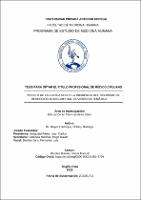| dc.contributor.advisor | Morales Ramos, Víctor Manuel | |
| dc.contributor.author | Reyes Cachique, Nohely Maitreya | |
| dc.creator | Reyes Cachique, Nohely Maitreya | |
| dc.date.accessioned | 2023-01-24T21:16:55Z | |
| dc.date.available | 2023-01-24T21:16:55Z | |
| dc.date.issued | 2023 | |
| dc.identifier.uri | https://hdl.handle.net/20.500.12759/10174 | |
| dc.description.abstract | Evaluar el efecto de la glicina sobre la incidencia del síndrome de resección
transuretral después de RTUP.
Métodos: Búsqueda de artículos en 5 bases de datos (Pubmed, Scopus, Web of Science,
Ebsco, Ovid) que cumplieron los criterios de selección. El riesgo de sesgo se evaluó con la
herramienta de la colaboración Cochrane para ensayos controlados aleatorios (ECA).
Las variables primarias fueron: síndrome de resección transuretral y glicina; las variables
secundarias que se evaluaron son: edad, tiempo operatorio, cantidad de tejido resecado.
Resultados: Se encontró 781 artículos; sin embargo, sólo 5 ensayos clínicos aleatorios
(ECAs) cumplieron los criterios de selección, con una población total de 868 pacientes.
Se dividió en dos grupos: en el primer grupo se utilizó glicina (n=380) y en el segundo
glucosa 5% y/o solución salina 0.9% (n= 488). La incidencia de síndrome de resección
transuretral se dio en 27 (7.1%) pacientes del grupo de glicina y ningún caso en el segundo
grupo; se determinó un RR= 8.02 (p= 0,002) en el grupo de glicina, demostrando que su
uso incrementa en 8 veces el riesgo de síndrome de resección transuretral. La influencia
de la edad (p=0.85); tiempo operatorio (p=0.82) y cantidad de tejido resecado (p=0.96), en
ambos grupos no mostró diferencias significativas en el desarrollo del síndrome de
resección transuretral.
Conclusiones: La glicina en comparación con otros irrigantes en la RTUP, incrementa la
incidencia del síndrome de resección transuretral. La edad, tiempo operatorio y la cantidad
de tejido resecado, no influyen en el desarrollo del síndrome de resección transuretra | es_PE |
| dc.description.abstract | To evaluate the effect of glycine on the incidence of transurethral resection
syndrome after TURP.
Methods: Search of articles in 5 databases (Pubmed, Scopus, Web of Science, Ebsco,
Ovid) that met the selection criteria. Risk of bias was assessed with the Cochrane
collaboration tool for randomized controlled trials (RCTs). The primary variables were
transurethral resection syndrome and glycine; the secondary variables evaluated were age,
operative time, amount of resected tissue.
Results: We found 781 articles; however, only 5 randomized clinical trials (RCTs) met the
selection criteria, with a total population of 868 patients. It was divided into two groups: in
the first group, glycine was used (n=380) and in the second group glucose 5% and/or saline
0.9% (n= 488). The incidence of transurethral resection syndrome occurred in 27 (7.1%)
patients in the glycine group and no cases in the second group; an RR= 8.02 (p= 0.002) was
determined in the glycine group, demonstrating that its use increases the risk of transurethral
resection syndrome by 8 times. The influence of age (p=0.85); operative time (p=0.82) and
amount of resected tissue (p=0.96), in both groups did not show significant differences in
the development of transurethral resection syndrome.
Conclusions: Glycine in comparison with other irrigants in TURP, increases the incidence
of transurethral resection syndrome. Age, operative time and the amount of resected tissue
do not influence the development of transurethral resection syndrome | en_US |
| dc.description.uri | Tesis | es_PE |
| dc.format | application/pdf | es_PE |
| dc.language.iso | spa | es_PE |
| dc.publisher | Universidad Privada Antenor Orrego | es_PE |
| dc.relation.ispartofseries | T_MED_3344 | |
| dc.rights | info:eu-repo/semantics/openAccess | es_PE |
| dc.rights.uri | https://creativecommons.org/licenses/by/4.0/ | es_PE |
| dc.source | Universidad Privada Antenor Orrego | es_PE |
| dc.source | Repositorio Institucional - UPAO | es_PE |
| dc.subject | Hiperplasia Benigna Prostática | es_PE |
| dc.subject | Glicina | es_PE |
| dc.title | Efecto de la Glicina sobre la incidencia del síndrome de resección transuretral: Revisión sistemática | es_PE |
| dc.type | info:eu-repo/semantics/bachelorThesis | es_PE |
| thesis.degree.level | Título Profesional | es_PE |
| thesis.degree.grantor | Universidad Privada Antenor Orrego. Facultad de Medicina Humana | es_PE |
| thesis.degree.name | Médico Cirujano | es_PE |
| thesis.degree.discipline | Medicina Humana | es_PE |
| dc.subject.ocde | https://purl.org/pe-repo/ocde/ford#3.02.27 | es_PE |
| renati.advisor.orcid | https://orcid.org/0000-0003-1453-9704 | es_PE |
| renati.author.dni | 73127519 | |
| renati.advisor.dni | 17915997 | |
| renati.type | https://purl.org/pe-repo/renati/type#tesis | es_PE |
| renati.level | https://purl.org/pe-repo/renati/level#tituloProfesional | es_PE |
| renati.discipline | 912016 | es_PE |
| renati.juror | Astigueta Pérez, Juan Carlos | |
| renati.juror | Valencia Mariñas, Hugo David | |
| renati.juror | Benites Jara, Fernando Luis | |
| dc.publisher.country | PE | es_PE |


